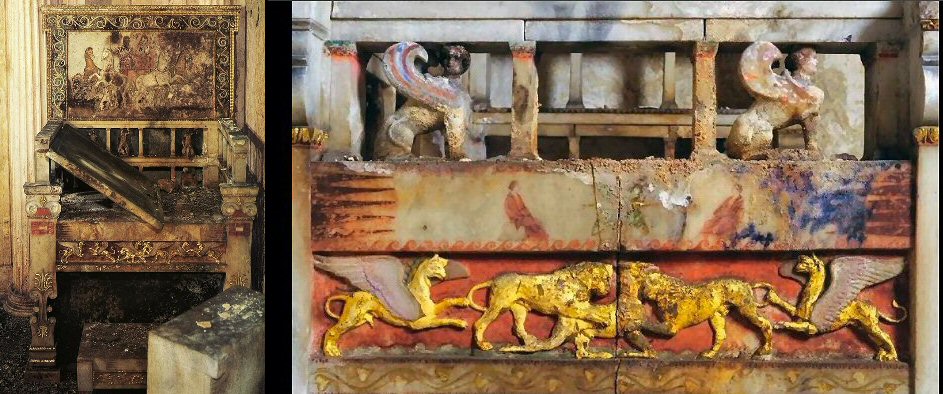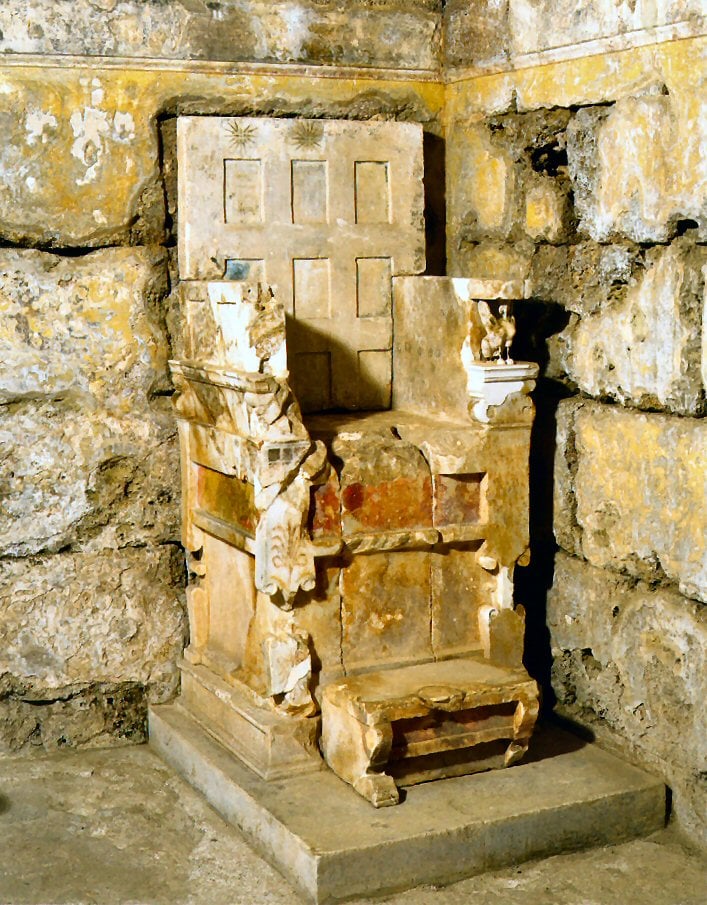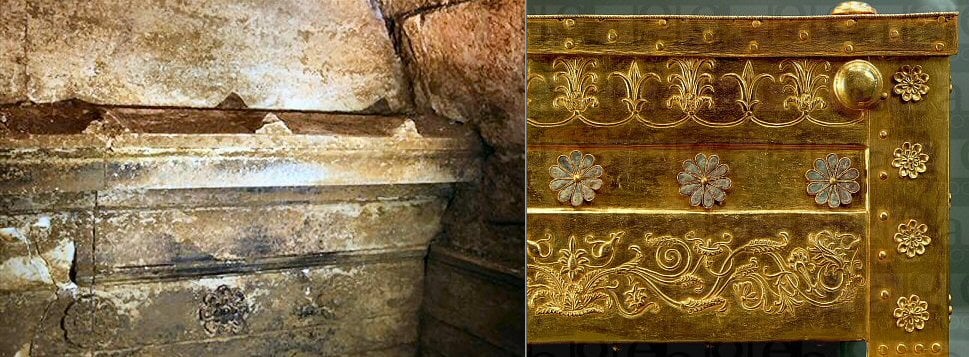By Andrew Chugg
Author of The Quest for the Tomb of Alexander the Great and several academic
papers on Alexander’s tomb says that in the recently discovered Greek tomb might be buried the mother of Alexander the Great.
The recently discovered sphinxes guarding the entrance to the Lion Tomb beneath the great mound at Amphipolis in Macedonia were unveiled on August 12th 2014 during a visit by the Greek prime minister, Antonis Samaras. They may be telling us more than has yet been realised about the occupant of this newly excavated tomb and its connections with other important Macedonian tombs of the period. That they are indeed sphinxes, rather than griffins or winged lions, is shown by the fact that both originally had human female breasts in the chest area. Despite the fact that these breasts, together with the heads and wings, were removed by deliberate mutilation at some time in the past, published photos clearly show the stone starting to protrude at the rims of the damaged patches
The tomb has been dated to the last quarter of the fourth century before Christ (325- 300BC) by the archaeologists, led by Katerina Peristeri. This was the period immediately following the death of Alexander the Great in 323BC. Sphinxes are not particularly common in high status Macedonian tombs of this era, but, significantly, sphinxes were prominent parts of the decoration of two thrones found in the late 4th century BC tombs of two Macedonian queens in the royal cemetery at Aegae (modern Vergina) in Macedonia. The first of these was found in the tomb attributed to Eurydice I, the grandmother of Alexander the Great. Carved sphinxes were among the decorations of its panels until they were stolen by thieves in 2001.
Secondly, a marble throne was found in another royal tomb close by the tomb of Eurydice I by K. A. Rhomaios in 1938. It was in pieces, but has since been reconstructed (Figure 4) and it has sphinxes as supporters for both arm rests and also royal Macedonian starbursts at the head of its back panel. Archaeology has shown that this tomb was never covered by the usual tumulus, so it may never have been occupied. It dates roughly to the end of the 4th century BC. Both of these tombs are from a section of the royal cemetery dominated by high status female graves and therefore known as the “Queens’ Cluster”.
Figure 4: The throne of a late 4th century BC queen from the Rhomaios tomb at Aegae It therefore seems that sphinxes were a particular symbol of late 4th century BC Macedonian queens. But why might Macedonian queens have associated themselves with sphinxes? One possible answer emerges from Greek mythology. Apollodorus 3.5.8 wrote: Laius was buried by Damasistratus, king of Plataea, and Creon, son of Menoeceus, succeeded to the kingdom. In his reign a heavy calamity befell Thebes.
For Hera sent the Sphinx, whose mother was Echidna and her father Typhon; and she had the face of a woman, the breast and feet and tail of a lion, and the wings of a bird. So the sphinx was the creature of Hera, Queen of the Gods and wife of Zeus. It is well known that the kings of Macedon traced their descent from Zeus via Heracles (e.g. Diodorus 17.1.5 and Plutarch, Alexander 2.1), that they put depictions of Zeus on their coinage and that they associated themselves with Zeus quite generally. They celebrated an important festival of Zeus at Dion and the people of Eresus in Lesbos erected altars to Zeus Philippios (M. N. Tod, A Selection of Greek Historical Inscriptions 2, 1948, no. 191.6) – possibly indicating the divinisation of Philip II in the guise of Zeus. If the Macedonian king posed as Zeus, it would consequently hardly be surprising if his senior queen became associated with Hera, the mistress of the sphinx.
The sphinxes at Amphipolis may therefore be interpreted as suggesting that the occupant of the tomb was a prominent queen of Macedon. Do we know from the historical record that any such queen died at Amphipolis in the last quarter of the 4th century BC? There are in fact two such candidates: Olympias, the mother of Alexander the Great and Roxane, his wife. The situation regarding Roxane is straightforward: she was killed on the orders of Cassander together with her 13-yearold son, Alexander IV, whilst imprisoned at Amphipolis in 310BC (Diodorus 19.52.4 & 19.105.2). The location of the death of Olympias is less clear, the only good evidence being the account of Diodorus 19.50-51. After Olympias surrendered to Cassander in the spring of 316BC at Pydna, he immediately sent troops to seek the surrender of her troops at Pella and at Amphipolis. Pella duly capitulated, but Aristonous at Amphipolis initially refused compliance. Therefore Cassander had Olympias write him a letter ordering him to surrender. After he had done so, Cassander immediately arranged the murders of both Aristonous and Olympias.
Although Olympias’s whereabouts at this point are ambiguous, it would seem very unlikely that Cassander did not himself go to Amphipolis with his army, given that these events took weeks to transpire. If so, it would seem likely that he took Olympias with him, rather than leave her alone in another part of freshly re-conquered Macedonia, potentially to be rescued by her supporters. Therefore there is a good chance that Olympias too died at Amphipolis. The tombs of Alexander’s father, Philip II, and of his son Alexander IV, were unearthed under another enormous mound in the royal cemetery at Aegae by Manolis Andronicus in the late 1970s. There are some interesting parallels between this pair of tombs and the new finds at Amphipolis. Firstly, elements of the painted decoration of the architectural elements at Amphipolis are a near exact match to such decoration in
the tomb of Alexander IV at Aegae .
Secondly, a spaced line of 8-petal rosettes newly discovered in the Amphipolis tomb provide a close match for the similar lines of rosettes that decorate the edge bands of the gold larnax from Philip II’s tomb at Aegae . Olympias will of course have been involved in arrangements for the entombment of her husband.
Thirdly, the lion monument that once stood atop the great mound at Amphipolis was reconstructed on the basis of its fragments by Jacques Roger and his colleagues in an article published in 1939 (Le Monument au Lion d’Amphipolis, BCH 63, pp. 4-42). There are close parallels between the façade of this monument and the facades of the tombs of Philip II and Alexander IV . Note also that the simulated roof edge at the top of the façade of the tomb of Alexander IV matches the simulated roof edge above the rosettes in the Amphipolis tomb .
Finally, it is interesting to note that the freshly revealed floor of white marble fragments fixed in a matrix of red cement in the vestibule of the tomb at Amphipolis has an exact match in a patch of flooring revealed in the late 4th century BC royal palace at Aegae.
On this evidence I consider Olympias to be the leading contender at the time of writing (6/9/2014) for the occupant of the magnificent tomb at Amphipolis currently being excavated with Roxane also a strong possibility. It should be recalled that the tomb mound has a diameter of 155m, larger even than the Great Tumulus at Aegae and posing the question of whom the Macedonians would conceivably have spent this much money and effort upon commemorating, Olympias is by far the most convincing answer at present. Although it is true that the ancient accounts say that she was unpopular at the time of her death, it is nevertheless clear that she was only really unpopular with Cassander’s faction, whereas Cassander himself was sufficiently worried about her popularity as to arrange her immediate death in order to prevent her addressing the Macedonian Assembly (Diodorus 19.51). Furthermore, her army under Aristonous stayed loyal to her cause long after she herself had surrendered. Ultimately, her cause was seen at the time as identical with the cause of Alexander himself, so it was in a sense Alexander whom they honoured by building his mother a spectacular tomb.
If it were objected that Cassander would not have allowed the construction of a magnificent tomb for his enemies, Olympias and/or Roxane, I would note that Cassander probably did permit the entombment of Alexander IV at Aegae, since his tomb seems to have been constructed during Cassander’s reign. I also see no cardinal reason for Cassander to have denied his enemies burial and it does not appear generally to have been the practice that rulers did not allow the entombment of dead enemies at the time. Counter examples are numerous, e.g. Arrian 3.22.1 wrote:
Alexander sent the body of Darius to Persepolis, with orders that it should be buried
in the royal sepulchre, in the same way as the other Persian kings before him had
been buried.
It is especially interesting and pertinent that another pair of monumental late 4th to early 3rd century BC freestanding female Greek sphinx sculptures was uncovered by Auguste Mariette in excavating the dromos of the Memphite Serapeum at Saqqara in Egypt in 1851 (Figure 9). These sphinxes are a very good parallel for the Amphipolis sphinxes and Lauer & Picard in their 1955 book on the Greek sculptures at the Serapeum argued that they date to Ptolemy I. A semicircle of statues of Greek philosophers and poets was also uncovered by Mariette in the dromos of the Memphite Serapeum near to the sphinxes (Figure 10) and Dorothy Thompson in her 1988 book on Memphis Under The Ptolemies suggested that the semicircle had
guarded the entrance of the first tomb of Alexander the Great at Memphis. I elaborated on this idea in my article on The Sarcophagus of Alexander the Great published in Greece & Rome in April 2002. Later, in the 2nd edition of my book on
The Quest for the Tomb of Alexander the Great (May 2012), I wrote in the context of discussing the semicircle: “In 1951 Lauer discovered a fragment of an inscription in the neighbourhood of some other Greek statues [including the pair of Greek sphinxes] standing further down the dromos of the Serapeum. It appears to be an artist’s signature in Greek characters of form dating to the early third century BC. It therefore seems likely that all the Greek statuary at the Serapeum was sculpted under Ptolemy I, hence these statues were contemporaneous with Alexander’s Memphite tomb.”
These monumental pairs of sphinx statues from the late 4th to early 3rd century BC may prove to be virtually unique to the Amphipolis tomb and the probable Serapeum tomb. (The only similar sphinxes I have yet discovered are the pair decorating an end of the lid of the “Lydian sarcophagus” found together with the “Alexander sarcophagus”, belonging to Abdalonymus, in the royal necropolis at Sidon.) If so, it greatly reinforces the connection of both the Amphipolis tomb and the Serapeum with Alexander. It potentially reinforces the dating of the Serapeum sculptures to Ptolemy I (which has been much disputed, though on scant evidence). It also directly connects the Greek sphinxes of the Serapeum with a royal Macedonian tomb of the late 4th century BC located in Macedon, thus boosting the candidacy of the Serapeum as the site of Alexander’s initial tomb, later moved to Alexandria. It is even possible that Olympias commissioned the sphinxes found at the Serapeum in order to decorate the tomb of her illustrious son at Memphis.
See all the latest news from Greece and the world at Greekreporter.com. Contact our newsroom to report an update or send your story, photos and videos. Follow GR on Google News and subscribe here to our daily email!









